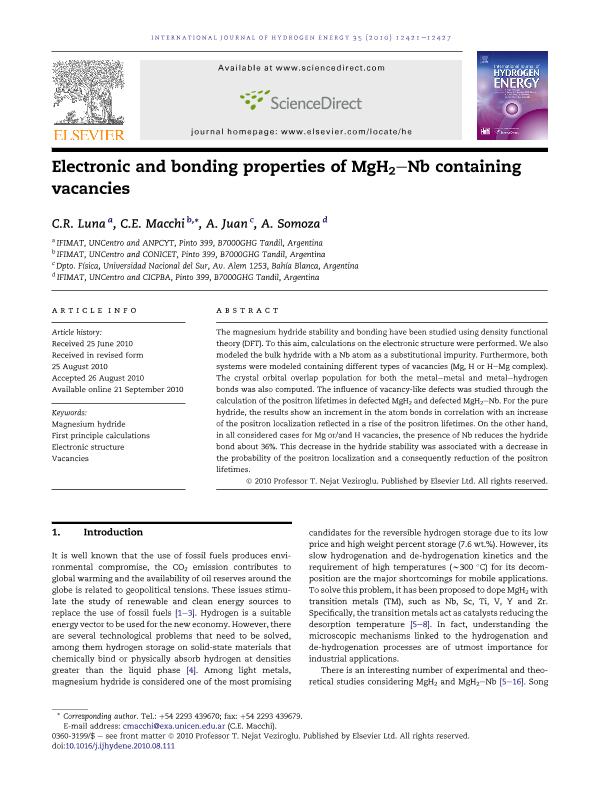Mostrar el registro sencillo del ítem
dc.contributor.author
Luna, Carla Romina

dc.contributor.author
Macchi, Carlos Eugenio

dc.contributor.author
Juan, Alfredo

dc.contributor.author
Somoza, Alberto Horacio

dc.date.available
2019-01-10T19:17:28Z
dc.date.issued
2010-11
dc.identifier.citation
Luna, Carla Romina; Macchi, Carlos Eugenio; Juan, Alfredo; Somoza, Alberto Horacio; Electronic and bonding properties of MgH2-Nb containing vacancies; Pergamon-Elsevier Science Ltd; International Journal of Hydrogen Energy; 35; 22; 11-2010; 12421-12427
dc.identifier.issn
0360-3199
dc.identifier.uri
http://hdl.handle.net/11336/67907
dc.description.abstract
The magnesium hydride stability and bonding have been studied using density functional theory (DFT). To this aim, calculations on the electronic structure were performed. We also modeled the bulk hydride with a Nb atom as a substitutional impurity. Furthermore, both systems were modeled containing different types of vacancies (Mg, H or H-Mg complex). The crystal orbital overlap population for both the metal-metal and metal-hydrogen bonds was also computed. The influence of vacancy-like defects was studied through the calculation of the positron lifetimes in defected MgH2 and defected MgH2-Nb. For the pure hydride, the results show an increment in the atom bonds in correlation with an increase of the positron localization reflected in a rise of the positron lifetimes. On the other hand, in all considered cases for Mg or/and H vacancies, the presence of Nb reduces the hydride bond about 36%. This decrease in the hydride stability was associated with a decrease in the probability of the positron localization and a consequently reduction of the positron lifetimes. © 2010 Professor T. Nejat Veziroglu. Published by Elsevier Ltd. All rights reserved.
dc.format
application/pdf
dc.language.iso
eng
dc.publisher
Pergamon-Elsevier Science Ltd

dc.rights
info:eu-repo/semantics/openAccess
dc.rights.uri
https://creativecommons.org/licenses/by-nc-sa/2.5/ar/
dc.subject
Electronic Structure
dc.subject
First Principle Calculations
dc.subject
Magnesium Hydride
dc.subject
Vacancies
dc.subject.classification
Astronomía

dc.subject.classification
Ciencias Físicas

dc.subject.classification
CIENCIAS NATURALES Y EXACTAS

dc.title
Electronic and bonding properties of MgH2-Nb containing vacancies
dc.type
info:eu-repo/semantics/article
dc.type
info:ar-repo/semantics/artículo
dc.type
info:eu-repo/semantics/publishedVersion
dc.date.updated
2019-01-02T18:24:30Z
dc.journal.volume
35
dc.journal.number
22
dc.journal.pagination
12421-12427
dc.journal.pais
Estados Unidos

dc.journal.ciudad
Nueva York
dc.description.fil
Fil: Luna, Carla Romina. Consejo Nacional de Investigaciones Científicas y Técnicas; Argentina. Universidad Nacional del Centro de la Provincia de Buenos Aires. Facultad de Ciencias Exactas. Instituto de Física de Materiales; Argentina
dc.description.fil
Fil: Macchi, Carlos Eugenio. Consejo Nacional de Investigaciones Científicas y Técnicas; Argentina. Universidad Nacional del Centro de la Provincia de Buenos Aires. Facultad de Ciencias Exactas. Instituto de Física de Materiales; Argentina
dc.description.fil
Fil: Juan, Alfredo. Consejo Nacional de Investigaciones Científicas y Técnicas; Argentina. Universidad Nacional del Sur. Departamento de Física; Argentina
dc.description.fil
Fil: Somoza, Alberto Horacio. Consejo Nacional de Investigaciones Científicas y Técnicas; Argentina. Universidad Nacional del Centro de la Provincia de Buenos Aires. Facultad de Ciencias Exactas. Instituto de Física de Materiales; Argentina
dc.journal.title
International Journal of Hydrogen Energy

dc.relation.alternativeid
info:eu-repo/semantics/altIdentifier/url/http://www.sciencedirect.com/science/article/pii/S0360319910017507
dc.relation.alternativeid
info:eu-repo/semantics/altIdentifier/doi/https://dx.doi.org/10.1016/j.ijhydene.2010.08.111
Archivos asociados
